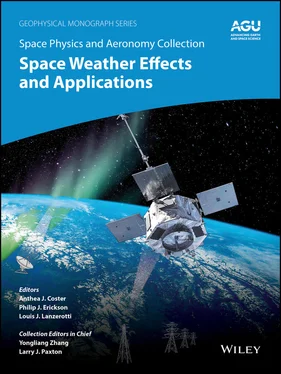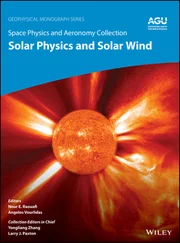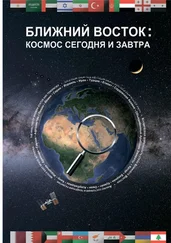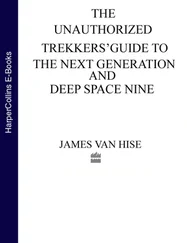(Source: Baker, 2005. Reproduced with permission from Springer Nature.)
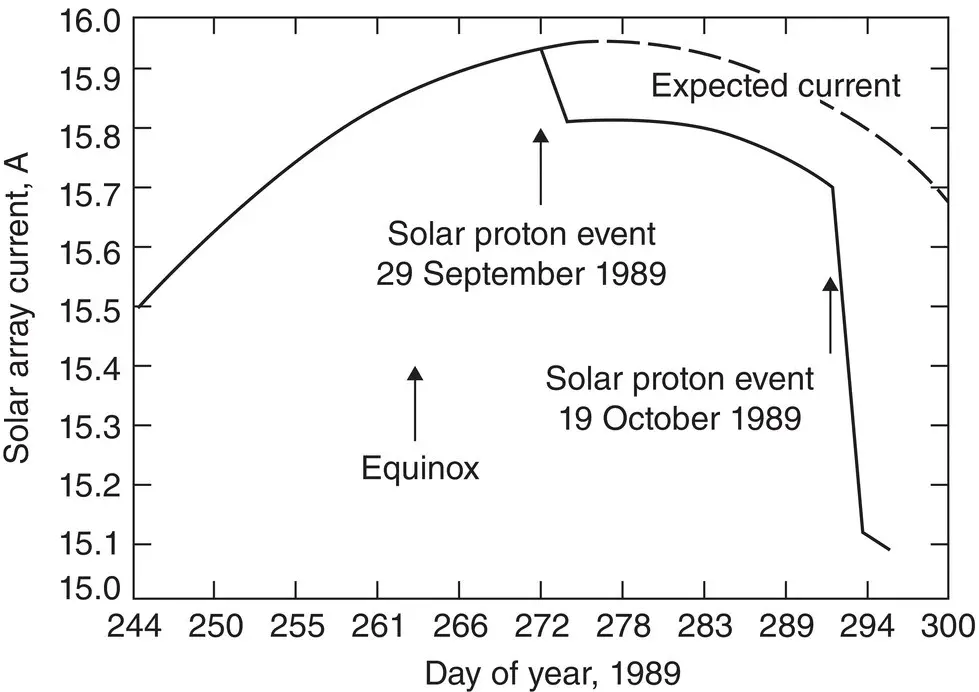
Figure 1.5 Observed solar array current reduction on a high‐altitude spacecraft following solar energetic particle events over a three‐week period in 1989.
(Source: Marvin & Gorney, 1991); reprinted by permission of the American Institute of Aeronautics and Astronautics, Inc.
In addition to the trapped population, there also are episodic solar energetic particle events, with enhanced energetic solar heavy ions. Those ions that eventually reach the Earth can penetrate deeply into the inner magnetosphere. At such locations, they can cause single‐event upsets and enhance the radiation damage to satellite solar arrays and electronic parts, similar to that shown in Figure 1.5(Marvin & Gorney, 1991). The Solar, Anomalous, and Magnetospheric Particle Explorer (SAMPEX) mission (see Baker et al., 1993) at LEO data showed multiple incidences of >15 MeV solar protons penetrating to low L combined with the presence of the protons from cosmic ray albedo neutron decay (CRAND) at very low L, and inherent variability of the proton fluxes in the 2.5 < L < 4 region in response to magnetic storms (Mazur et al., 2005). This CRAND mechanism was the first idea put forth to explain the existence of trapped energetic particles in the magnetosphere (see Van Allen, 1983).
Solar energetic particle events are the mechanism by which very high‐energy protons appear in the outer zone region of the radiation belts. However, these events are very short lived (hours in duration), as the high‐energy protons with such large gyro‐radii are not able to be stably trapped at these locations. As noted, they can often penetrate to the inner zone, where stronger magnetic fields in a more rigid magnetic topology can entrain these particles for long times. In general, highly energetic protons (multi‐MeV energies) are not considered to be a regular feature in the outer zone (see Selesnick et al., 2014).
The characteristics and dynamics of relativistic and ultrarelativistic electron fluxes in Earth’s outer radiation belt are strongly influenced by geomagnetic storm time processes. These lead both to significant electron loss and local acceleration deep within the inner magnetosphere. The outer Van Allen belt is highly variable on essentially all temporal scales and shows tremendous variability as well as significant variations in the outer belt spatial extent. This is well illustrated by Figure 1.6adapted from Li et al. (2006). The main (lower) panel of the figure shows integral fluxes of 2 ≤ E ≤ 6 MeV electrons measured by sensors on board SAMPEX. The data are color‐coded representations of electron flux from L = 2.0 to L = 7.0 (vertical axis) versus time (horizontal axis) from 1992 to 2013. The color bar to the left is the log of electron flux (electrons/cm 2‐s‐sr). The upper panel of Figure 1.6shows in black the smoothed sunspot number over the period 1992–2013, while the red trace shows the solar wind speed (km/sec) measured upstream of the Earth’s magnetosphere.
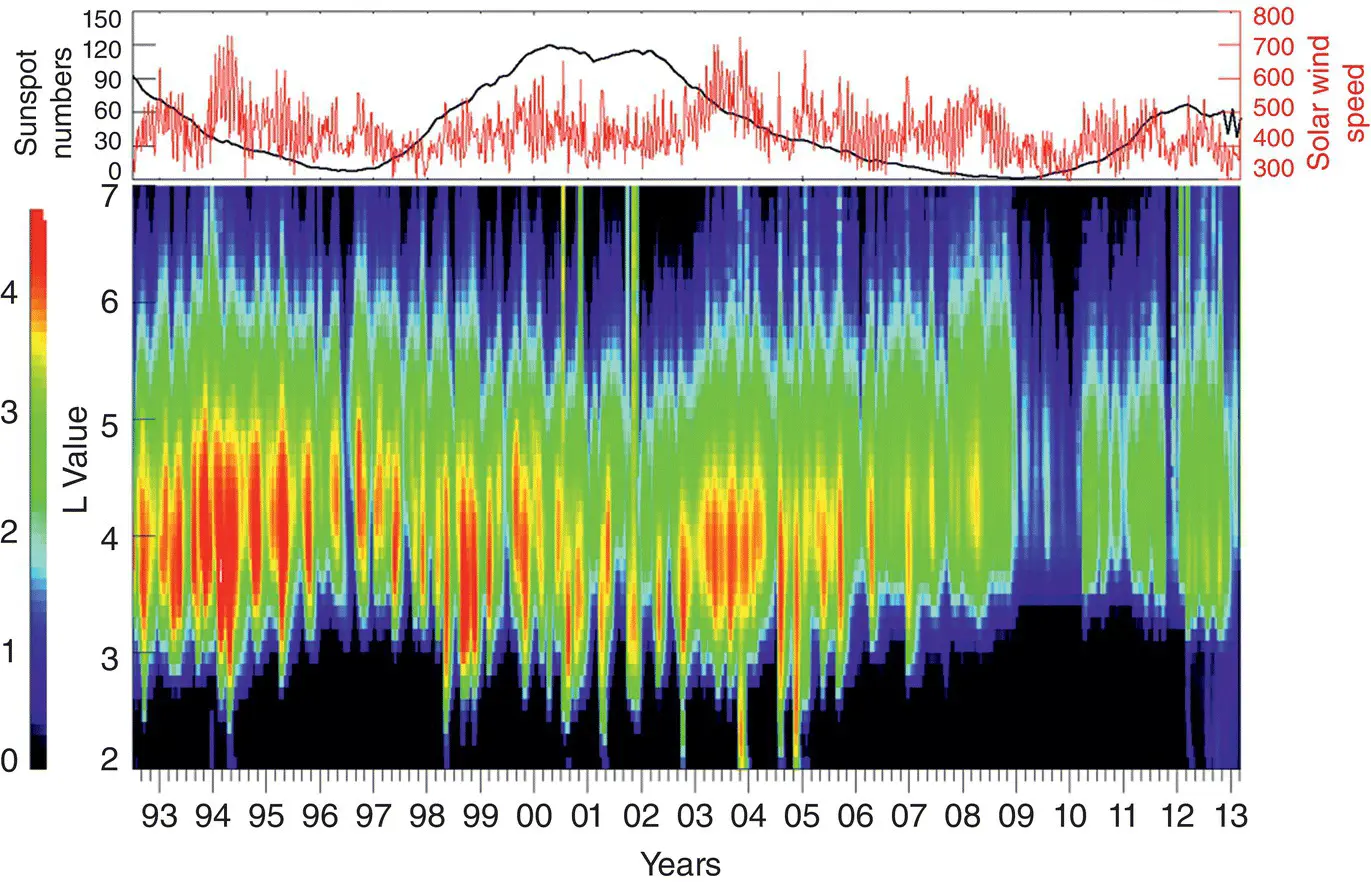
Figure 1.6 Long‐term (1992–2013) record of 2 ≤ E ≤ 6 MeV electrons measured primarily by the SAMPEX spacecraft at low altitude. The upper panel shows smoothed sunspot number (black) and solar wind speed (km/sec; red trace) for the same period of time
(Source: X. Li.)
As is evident from the figure, the outer Van Allen belt (as monitored from the ~500 km altitude of SAMPEX) typically extends from L ~ 3.0 to roughly L = 6.5. However, the belt’s spatial extent was highly variable over the ~20‐year SAMPEX lifetime. Also, the peak electron flux levels varied widely as a function of time. For example, in 1994, the peak >2 MeV electron fluxes were over 10 4electrons/cm 2‐s‐sr, while in 2008–2009 the electron flux was often barely above background levels (~10 0electrons/cm 2‐s‐sr). As is obvious from inspection of the figure, a main controller of the electron fluxes in the outer belt is the solar wind speed impacting Earth’s magnetosphere (Baker et al., 1987). Indeed, solar wind speeds with V > 500 km/sec generally are associated with high outer radiation belt electron “content” (Baker, 2004). On the other hand, persistent solar wind speeds of V ≤ 300 km/sec can lead to virtual disappearance of the outer belt (for electron energies E ≳1MeV). This occurred quite prominently in the profound solar minimum of 2008–2009.
The inner “edge” of the outer zone, as is obvious in Figure 1.6, shows considerable variability in spatial location. During particularly strong solar wind forcing conditions, the inward extent of the outer zone population can appear to reach down to L ~ 2.5. This is typically a rare and brief circumstance. During truly extreme forcing events such as the Halloween Storm events of late 2003 (see Baker et al., 2004), the slot region can be filled with multi‐MeV electrons for weeks of time. An event of great strength was also seen in late 2004 (see Figure 1.6).
It has long been clear that large increases in multi‐MeV electrons can cause significant spacecraft operational anomalies. For example, Figure 1.7(taken from Baker, 1987) shows that star‐tracker anomalies were observed on an operational geostationary Earth orbit spacecraft whenever the counting rate for E ~ 3 MeV electrons reached or exceeded 7 counts/sec. The vertical arrows show the precise timing relationship between the star tracker problems and the enhanced electron flux episodes during this 1980–1982 period. Many other electron‐induced anomalies have been documented over the space age (see Baker, 2005, and references therein).
A final point to note is that newer spacecraft technologies can be quite susceptible to space radiation effects. An example is fiber optic cabling that is increasingly used on operational spacecraft. Different fiberglass materials and different designs can show substantially different induced attenuations of signals with increasing radiation dose exposure. An example is shown in Figure 1.8from a study by Alam et al. (2006).
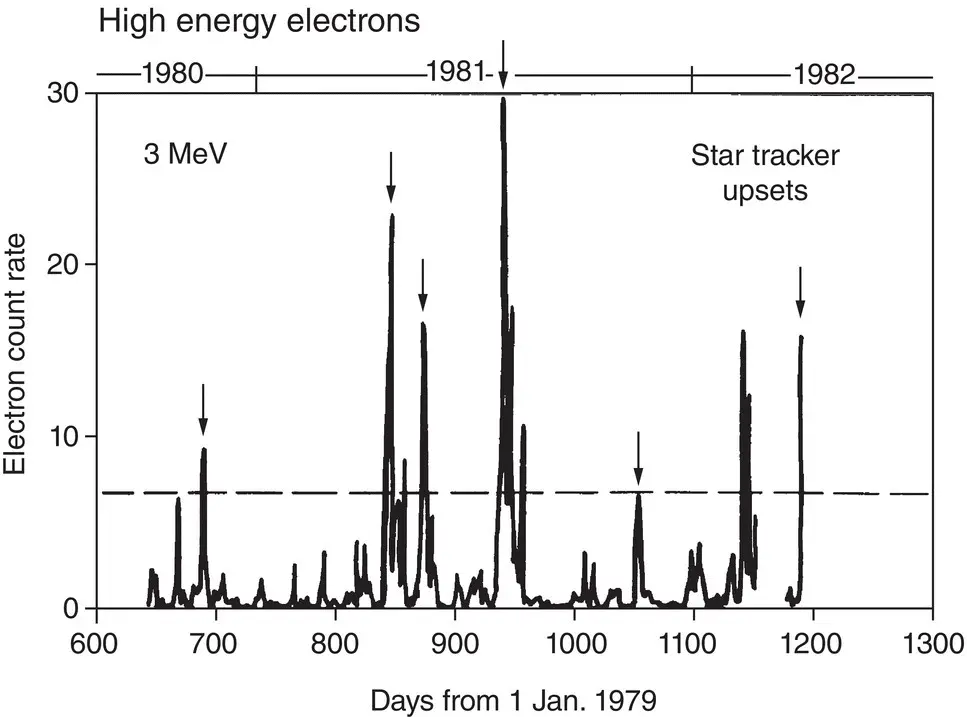
Figure 1.7 Temporal correspondence between star tracker anomalies onboard a geostationary orbit spacecraft (vertical arrows) and enhancements in E ~ 3 MeV electron fluxes measured by sensors on the same spacecraft.
(Source: Baker, 1987.)
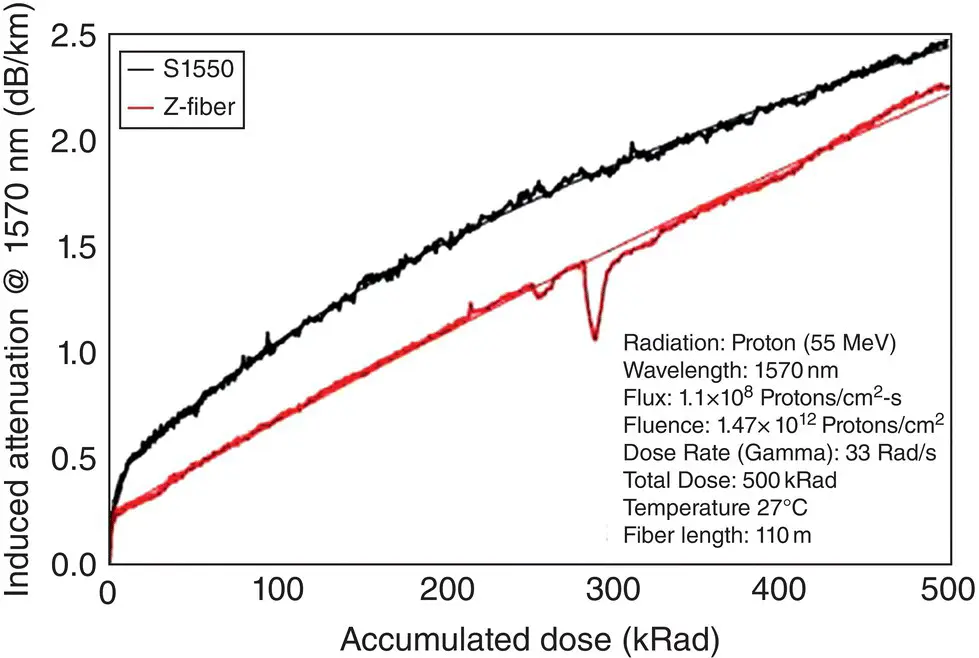
Figure 1.8 Induced attenuation of fiber optic cabling signals due to accumulated proton dose for two different types (S1500 and Z‐fiber®) of material
(Source: Alam, https://www.spiedigitallibrary.org/conference‐proceedings‐of‐spie/10567/105672M/Performance‐of‐optical‐fibers‐in‐space‐radiation‐environment/10.1117/12.2308184.full?SSO=1. Licensed under CC BY SA 4.0)
Figure 1.8shows induced attenuation growth versus accumulated proton dose plots for the two fibers. S1550‐HTA fiber with the higher NA (0.16) performs fairly well in comparison to Z‐fiber®, which has relatively smaller NA (0.12). For both fibers, attenuation growth data can be represented well by the three‐term “saturating exponentials” model (Alam et al., 2006). Solid lines in the figure represent best fit to the data. S1550‐HTA shows a trend towards saturation, while Z‐fiber® does not indicate any such behavior. Using the data acquired, radiation‐induced attenuation of S1550‐HTA fiber at room temperature and to a total accumulated dose of 50 kRad was predicted to be 1.33 dB/km and 0.76 dB/km in γ‐ and proton radiation environments, respectively.
Читать дальше
